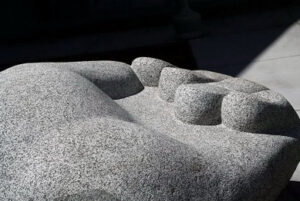
Home » Carve » Experience » Getting Started » Splitting Granite
Part of this material I used in the 20 hour granite course I taught at Pratt. Most of the info is from Tom Urban’s workshop at Camp Brotherhod, some from a workshop by Don Ramey that Hank Nelson organized at my place years ago. If you find anything useful, please add it to the article – Kirk
Granite is removed either by impact or by abrasion, not by carving through the stone. Stone will break and carve more easily in one direction, known as the “grain”. Slabs are usually sawn so grain runs long way, thus breaking is across the grain
Granite tends to split towards an edge. The closer you are to an edge with splitting tool, the more the crack tends to run to the outside rather than down through the stone.
Depending upon the situation and piece of stone, three techniques can be used: “Plugs and Feathers”, “Saw Cuts and Weges”, and ” Pitching”
Lay out line for splitting. Enough mass must lie on either side of line to prevent breaking out to side. Can make gentle curves. Drill holes about 6 inches apart using rotohammer and carbide-tipped drill bits. Can alternate drill bits to keep them cool. Hilti makes “Jet Head” bits that have 4 carbide blades, creating round hole instead of oblong. Watch out for drilling through the stone, as bit tends to bind, causing drill to spin around and possible injury. Also, freeing stuck bit can be a problem. Feathers go parallel to line. Some claim deeper holes make straighter split, but in granite generally just make holes deep enough to accept plugs. Taking time to set plugs gives evener split. Set plugs tight, then leave for a couple of hours (or overnight). Softer granites split more slowly.
Can break off large masses using saw cuts and splitting off with steel wedges. This method tends to split to edge more than plugs & feathers. Tapered ends of auto leaf springs work well as wedges.
Pitching tool is placed on stone along line of split. Tracer is used straight up-and-down, hand set is tilted back slightly to give sharp edge. Pitch on top, force directed to bottom. Irregular surface: lay down a saw cut or tracer line before using hand set or use smaller chisel so you don’t chip edge of tool.
Depth of crack depends on how hard you hit it the first time. Force of blow wants to move out to edge, so you have to relate how far back you go from edge to depth of crack, e.g., on 8” thick slab at least 2” from edge. Weight of hammer for pitching seems to be carver’s choice.
https://trowandholden.com/stone-splitting.html
Pro Tip: Can use angle iron under the stone to help direct force through stone. Place stone on top of angle (apex up) and pitch in line directly above angle.






We need some kind of descriptive text here.